Make and store this aromatic sambar powder (sambar podi) to easily cook up the most delicious south Indian sambar. This dry spice mix is made by roasting and then blending together spices and legumes, which, together, add the most amazing flavor and create the perfect texture in the finished dish.
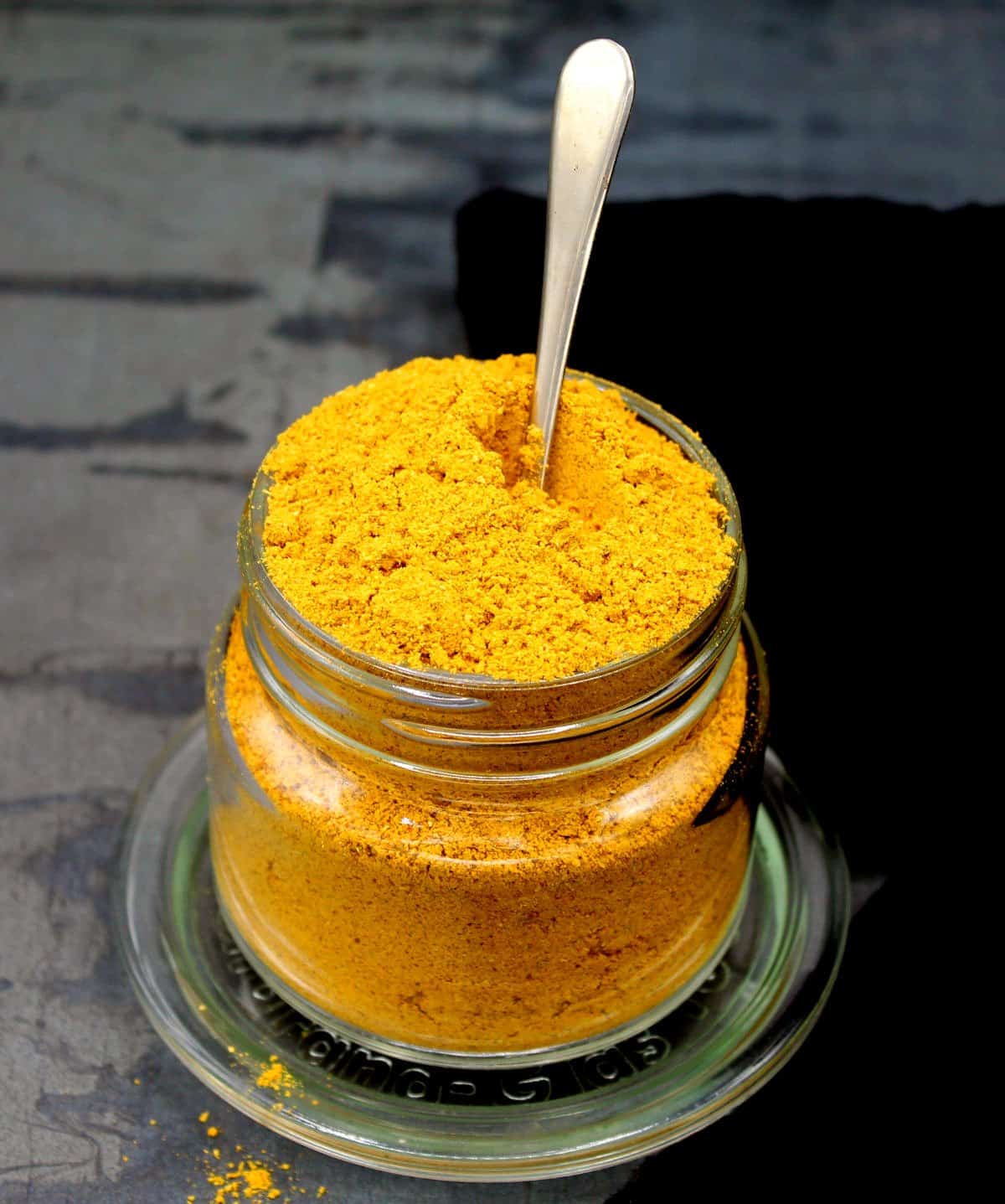
Powdered Indian spice mixes like garam masala and curry powder usually take very little time to make and once you have them on hand cooking healthy, tasty recipes just becomes so much easier. One spice blend I always have in my pantry, thanks to my Tamil husband's love for the food of his native land, is sambar powder.
Table of Contents
What is sambar powder?
Sambar powder/sambhar podi, alongside rasam powder, is a mainstay spice blend of south Indian Tamil cuisine. It's a finely blended mix of two or three types of lentils, whole spices like cumin, coriander and red chili peppers, turmeric powder, and, optionally, an herb--curry leaves. Added to cooked lentils with vegetables and tamarind, it results in an amazingly delicious dal called sambar or kuzhambu.
You've likely eaten a sambar if you've eaten a dosa or idli at an Indian restaurant. It's the yellow-red dal with veggies that gets served alongside coconut chutney to dunk the idli or dosa into. Making a sambar is extraordinarily easy if you have the right ingredients, and it all begins with an excellent sambar powder.
Why you should have a jar of sambar powder in your pantry
- Sambar powder makes easy work of delicious dals and dry vegetable stir-frys or curries. If you love south Indian food you already know what I am talking about. If you are unfamiliar with it but love exploring new flavors at the dinner table you will likely adore this new addition to your repertoire for its vivid flavors.
- It is easy to make. The recipe takes no more than 30 minutes of your time to put together. This recipe makes about three cups of the spice blend which should easily last you for 24-30 uses. If you want to make less, especially at your first try, use the slider in the recipe card below to adjust the quantities of the ingredients.
- It's highly versatile. A sambar powder, likely because it was the precursor to curry powder, has a similar taste, so you can use it in any recipe that calls for curry powder. You can also add it to any dal recipe to dial up the flavor.
- It's good for you. Spices, as you already know, are great for you, and so are lentils. A serving of approximately 1 ½ tablespoons of this spice mix will add two grams of protein and three grams of dietary fiber to your recipe. And there is no added fat here.
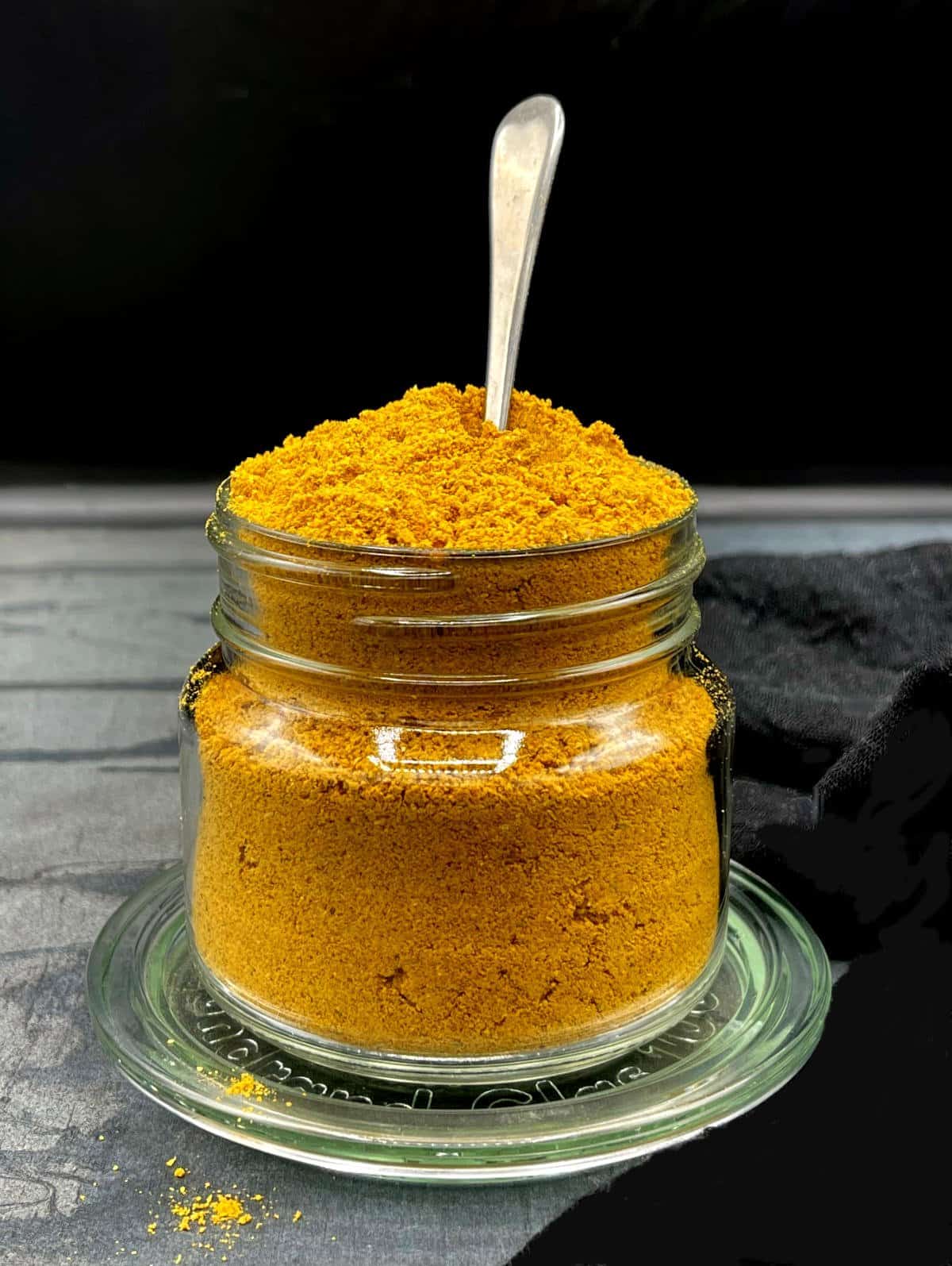
Ingredients
- 1 ¼ cup coriander seeds
- 1 loosely packed cup of dry red chili peppers (about 30 peppers). This might seem like a lot but remember this recipe makes nearly 30 servings. If you love a lot of heat in your food you can add up to 15 more peppers. Use any moderately hot chili pepper here that's available online or at an Indian store, like byadgi or Kashmiri. There is also some black pepper in this recipe so if you are sensitive to heat scale back, if you wish, to half a cup of chili peppers.
- ⅓ cup chana dal (Bengal gram dal). These are split chickpeas (kala chana).
- ⅓ cup tuvar dal (toor dal/tur dal/pigeon peas)
- 2 tablespoon urad dal (black gram dal, optional). You can make a perfectly good sambar masala without the urad dal but I like the thickness it adds to the sambar so I use a bit of it here.
- 2 tablespoon cumin seeds
- 1 tablespoon fenugreek seeds (methi dana or methi seeds)
- 1 tablespoon black peppercorns
- ¼ cup curry leaves. You can use either fresh curry leaves or dry in this recipe. Some south Indians don't use curry leaves in their sambar powder and you can leave them out, but if you do that be sure to add fresh curry leaves to the sambar when you are making it. I usually add it both to the sambar masala and to the sambar when I'm cooking it.
- 2 tablespoon turmeric
How to make sambar powder
- ROAST THE INGREDIENTS:
- Dry roast the red chili peppers in a medium skillet over medium-low heat for about five minutes or until they turn almost crispy. Remove to a plate and set aside to cool. (Be sure to turn on your vent hood or vent fan or leave a window in the kitchen open any time you roast chile peppers.)
- In the same skillet add the remaining ingredients except the turmeric and the curry leaves. Roast them over a low heat setting--I usually keep my stove turned on to the setting to 1 or 2. Slow-roast the ingredients until they have slightly changed color and are very aromatic. This takes me about 10 minutes. You don't want to cook the ingredients too much here. Traditionally sambar ingredients were dried in the hot south Indian sun before being blended and that's what we are trying to emulate here.
- Remove the roasted ingredients to a plate and set aside.
- Finally, roast the curry leaves, if they are fresh, until they are very dry and crisp. If you are using dry curry leaves you can skip this step.
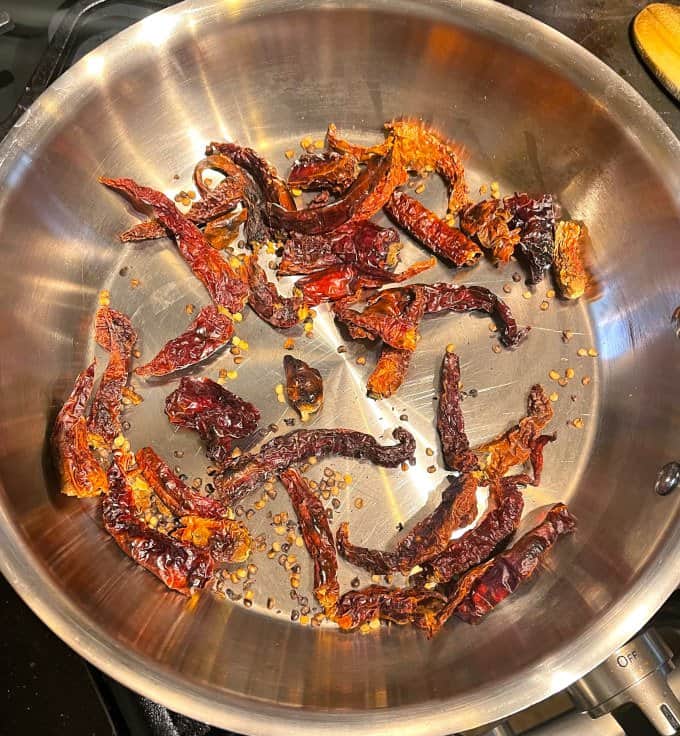
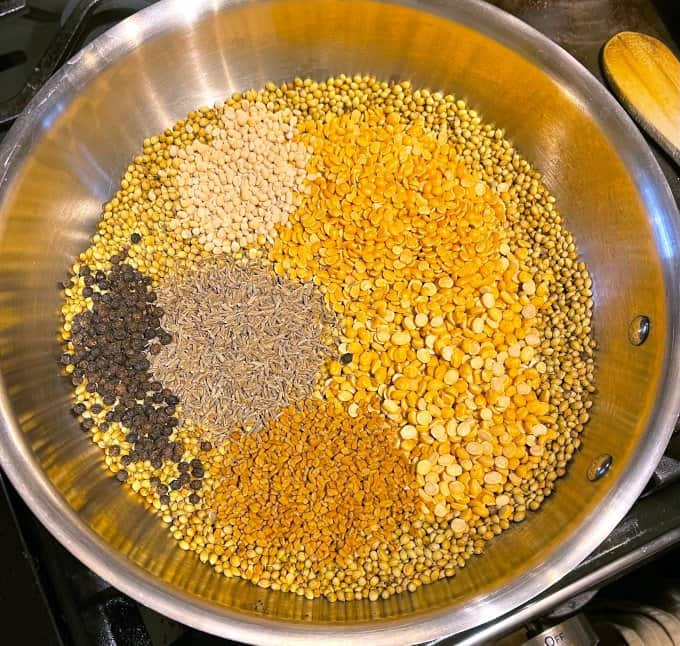
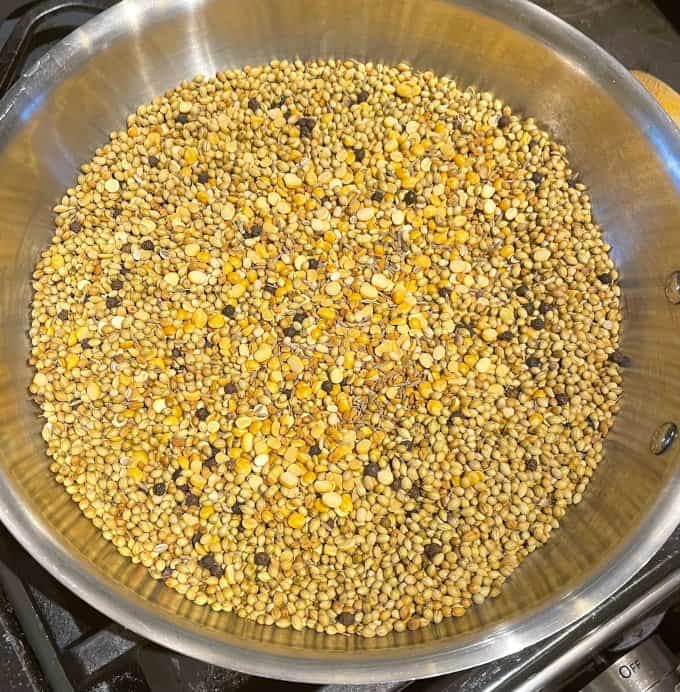
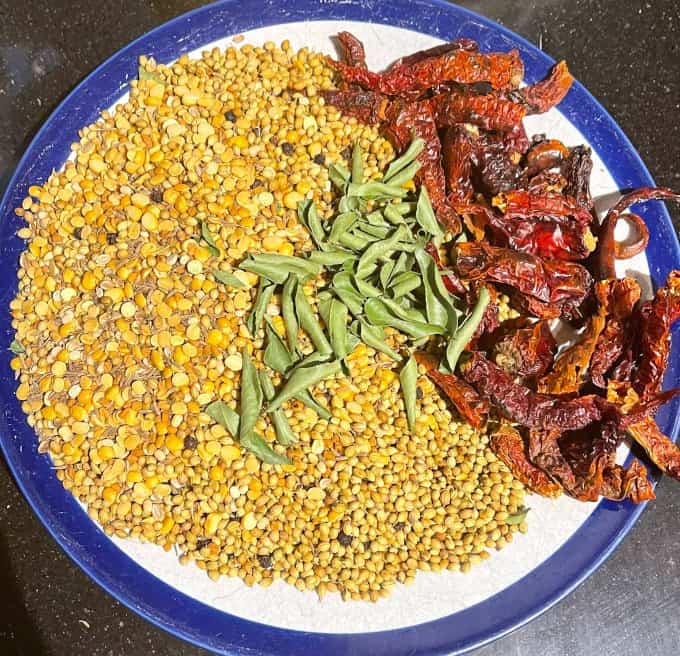
- BLEND THE SAMBAR MASALA
- Once the ingredients have cooled you can begin blending them. Begin by blending the chile peppers first. It really helps to have a powerful blender here that can make a fine powder.
- Once the chile peppers have broken down into a powder add the remaining ingredients to the blender jar, including the turmeric powder and curry leaves, and grind again into as fine a powder as possible.
- SIFT THE MASALA BLEND
- This is an optional step but most south Indians would do this, and I highly recommend you do too because you want the sambar powder to be as smooth and fine as possible so your sambar is silky in texture. Any coarse ingredients you sift out can be blended again and added to the sifted powder, or reserve this blend in a separate jar and use it to season dry curries like these Bombay Potatoes.
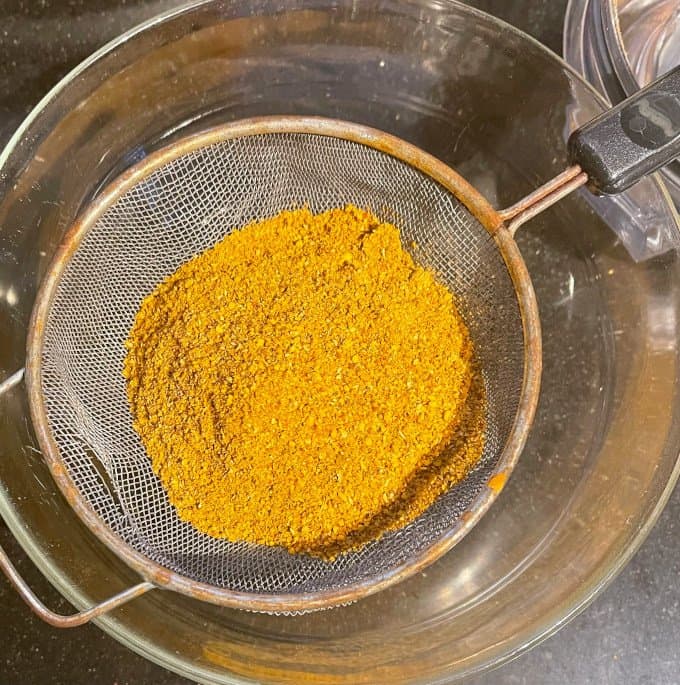
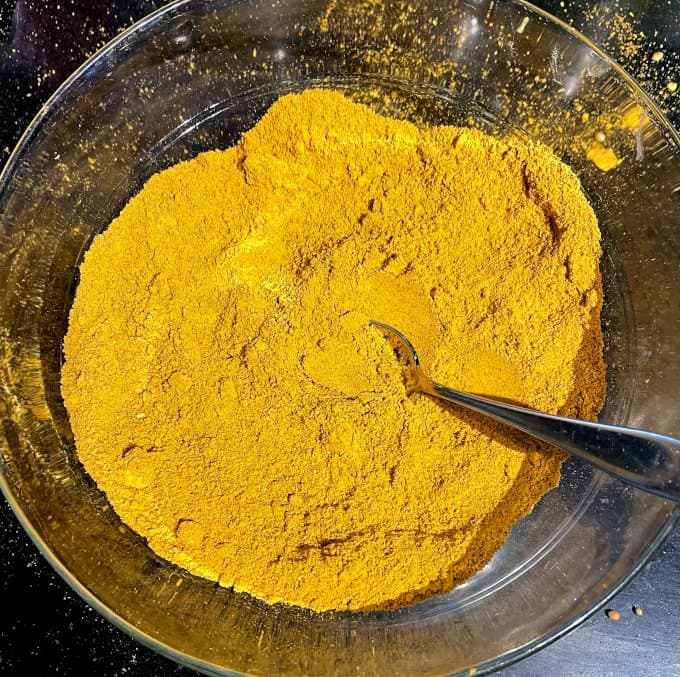
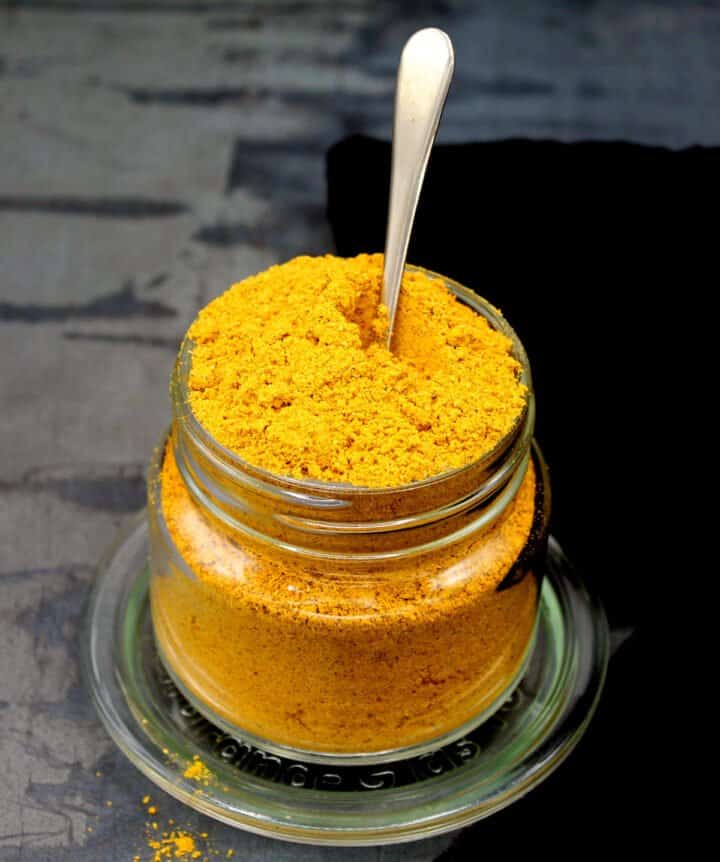
You can add the sambar podi to any south Indian dal, like a sambar, kootu or kuzhambu. Or use it to flavor just about any Indian dal, or a sabzi. It also makes a great substitute in recipes that call for curry powder because it has many similar flavors.
I strongly recommend buying the ingredients at an Indian grocery store, if you have access to one, because the prices are much better. However, if you don't have access to an Indian store, or would like to purchase only organic spices, you will need to look online. I have included some Amazon affiliate links in the recipe card below.
For each cup of dry lentils I'd add between one to two tablespoons. If a sambar or dal recipe calls for a freshly blended masala paste of coriander seeds, dry red chillies, chana dal, cumin seeds and asafetida you can just use the sambar powder instead.
Sambar powder should preferably be added to the pan closer to the beginning of cooking, to the tamarind juice or along with other powdered spices. Remember that it is not fully cooked, like garam masala is, so it needs some quality time over heat to fully develop its flavors.
Store the spice blend in an airtight mason jar for up to a year in a cool, dark place, or, preferably, in a fridge, which will extend its life.
Recipes to use sambar powder in
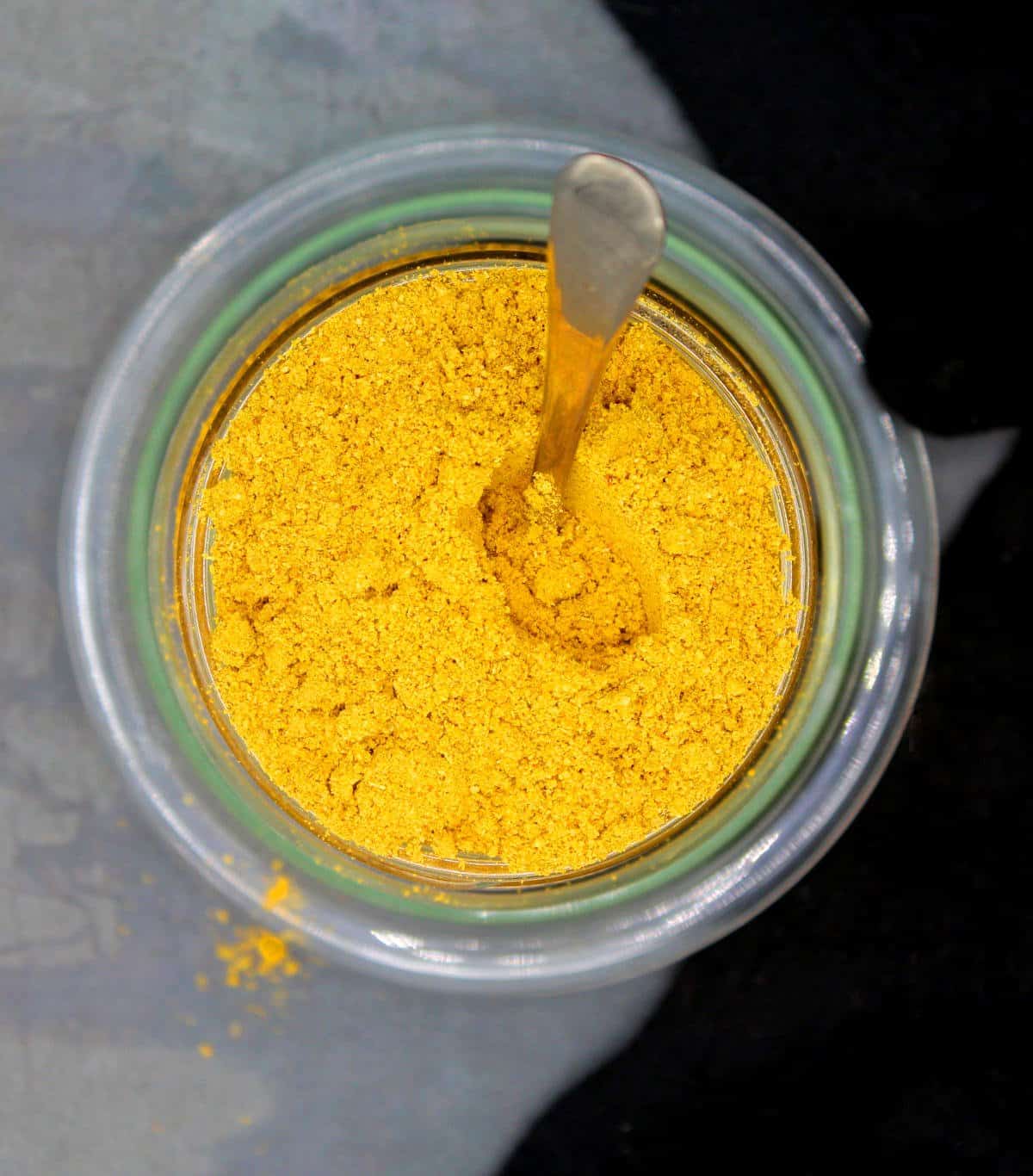
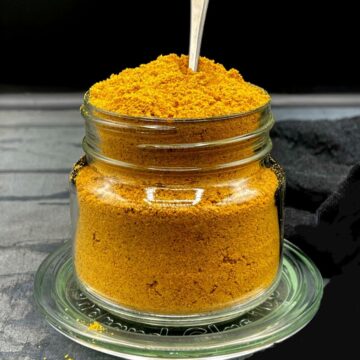
Sambar Powder (Sambar Masala)
Equipment
- 1 powerful blender (or spice grinder or coffee grinder)
- 1 Skillet or wide pan
Ingredients
- 1¼ cups coriander seeds
- 1 cup dry red chili peppers (like Kashmiri red chili peppers or byadgi peppers, loosely packed. Use moderately hot peppers. This sambar masala is not too hot but if you are very sensitive to heat you can cut down the quantity of peppers by half)
- ⅓ cup chana dal (Bengal gram dal)
- ⅓ cup tuvar dal (split pigeon peas)
- 2 tablespoons urad dal (black gram dal, optional)
- 2 tablespoons cumin seeds
- 1 tablespoon fenugreek seeds (methi dana)
- 1 tablespoon black peppercorns
- ¼ cup curry leaves (fresh or dry are both fine. Some south Indians don't use curry leaves in their sambar powder and you can leave them out, but if you do that be sure to add fresh curry leaves to the sambar when you are making it.)
- 2 teaspoons turmeric
Instructions
Roast the ingredients
- Dry-roast the red chili peppers in a medium skillet over medium-low heat for about five minutes or until they turn almost crispy. Remove to a plate and set aside to cool. (Be sure to turn on your vent hood or vent fan or leave a window in the kitchen open any time you roast chile peppers.)
- In the same skillet add the remaining ingredients except the turmeric and the curry leaves. Roast them over a low heat setting--I usually keep my stove turned on to the setting to 1 or 2. Slow-roast the ingredients until they have slightly changed color and are very aromatic. This takes me about 10 minutes. You don't want to cook the ingredients too much here. Traditionally sambar ingredients were dried in the hot south Indian sun before being blended and that's what we are trying to emulate here.
- Remove the roasted ingredients to a plate and set aside.
- Finally, roast the curry leaves, if they are fresh, until they are very dry and crisp. If you are using dry curry leaves you can skip this step.
Blend the sambar powder
- Once the ingredients have cooled you can begin blending them. Begin by blending the chile peppers first. It really helps to have a powerful blender here that can make a fine powder.
- Once the chile peppers have broken down into a powder add all of the remaining ingredients to the blender jar, including the roasted spices and lentils, turmeric and curry leaves, and blend into as fine a powder as possible.
Sift the sambar powder
- This is an optional step but most south Indians would do this, and I highly recommend you do too because you want the sambar powder to be as smooth and fine as possible so your sambar is silky in texture. Use any sieve or strainer to sift the blended powder into a bowl. Any coarse ingredients you sift out can be blended again and added to the sambar powder. Or reserve this blend in a separate jar and use it to season stir-fried vegetable curries.
Store the sambar powder
- Store the sambar powder in an airtight mason jar for up to a year in a cool, dark place, or, preferably, in a fridge, which will extend its life.

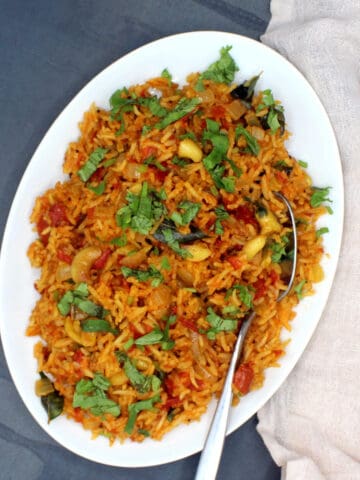
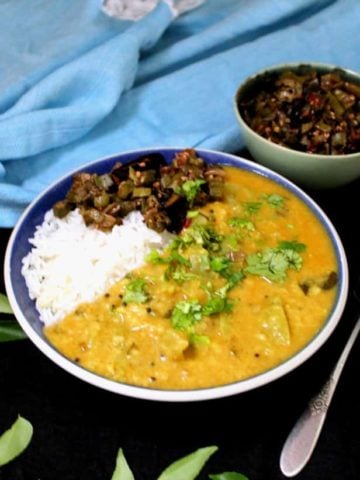
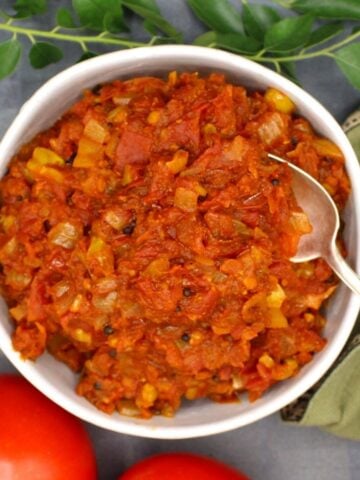
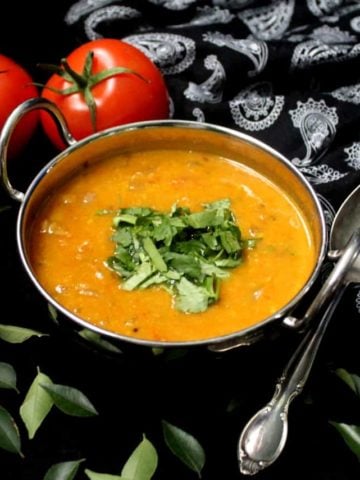
jim
Hello Vaishali,
First thank you for this inspiring food blog that is a lot of fun to read too, I can tell you were trained as a journalist you do your research and I learn from it. I wonder if it is possible to grind the beans in a coffee grinder since this is what I use to grind my spices. Probably not ideal but would it work, do you have ecperience doing so?
I'm a vegetarian for about 40 years now, love the Indian kitchen (and the Ethiopian btw) to bits. Such a variety of flavours and combinations and I love spicy food. (I can't rate the recipe since I didn't make it but I love Sambar and the south indian kitchen so will give it three stars only if required to be able to post a comment for now and hope you don't mind.) And hey, Spinach and mushrooms are a great combo I'll check the recipe out too! Loved your writing on the Vegetable Vindaloo and learned a thing or two. Glad I found your site! All the best.
Vaishali
Hi Jim, it's best to have a dedicated spice grinder for spices and not use it for coffee as well, unless you like spice-flavored coffee! 🙂
Thanks for your kind words, I am so happy you liked the vindaloo post and others. Hope you make the sambar and if you do, would love to hear how it went!
SNL
I only have 1 powerful coffee/spice grinder (whatever the name on the box said) and have used it for both coffee and spices. To clean out the smells, I wipe the grinder bowl with a good piece (thick) of kitchen roll (make sure you get all of the powder out) and then leave exposed overnight (I have no idea why it works but it becomes odourless). For the lid, as I can wash it, I do and again leave it out overnight to dry fully.
PamelaB
I love this! The idea of adding to rice or lentils is such a great idea.
What about adding a bit while scrambling eggs…?
Or mashed potatoes or sweet potatoes…mashed squash?
Would it work as a dusting of flavor to sautéed greens…what do you think?
(I’m inclined to look/go outside the box)😏
Vaishali
Hi Pamela, I love that you are looking outside the box! All of your suggestions are wonderful and I'd say go for it. I think the flavor would be especially wonderful with sweet potatoes and squash. It could also work with eggs but you might want to add some veggies to the scrambled eggs for balancing flavors.
You can also make a simple curry like this one using sauteed greens, mushrooms and coconut milk with sambar powder (instead of curry powder): https://holycowvegan.net/mushroom-spinach-curry/